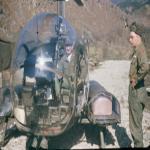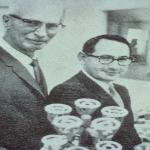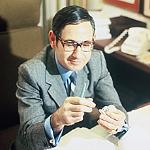15 November 2010

Photo: Courtesy Albert Starr
Albert Starr was one of the first doctors to enter the field of open-heart surgery and went on to help develop a mechanical replacement for the heart's mitral valve.
Cardiac medicine has made tremendous strides since the 1950s, when surgeons placed the first experimental artificial valves in the human heart.
One of the pioneers in that field is Dr. Albert Starr, who co-invented the heart value - which has extended the lives of millions of people.
Early start
Albert Starr was just 16 when he enrolled at Columbia University in New York during World War II.
At that time, school offered accelerated programs for young men heading off to war.
He finished in two years, and by the time he was 22, had completed medical school.
By then, World War II had ended, but the United States was involved in the Korean War so Starr decided to become a military doctor.

Courtesy Albert Starr
Albert Starr (in helicopter) as a as a young surgeon in Korea
"At first, I was a battalion surgeon on the front line, getting shot at. And then I was transferred to a mobile army surgical hospital, a MASH 8076, and I spent a year there," says Starr. "During that year, I did more than 1000 major operations, just as a young kid. I mean, I was 23 years old."
It was a perfect training ground for the future heart surgeon. After leaving the military, Starr moved into the new field of open-heart surgery.
New field
"But it was very limited in scope because you couldn't take too long to do these operations. It would injure various vital organs, especially the brain," he says. "So we had to develop a mechanical device to imitate the lungs and the pumping action of the heart, the heart-lung machine, and it was that development that allowed the growth of open-heart surgery."

Courtesy Albert Starr
Pioneering heart surgeon Albert Starr
Researchers in Philadelphia developed that machine in the 1950s. It pumped oxygenated blood through the body, giving surgeons enough time to try to correct faulty heart valves, including the mitral valve inside the heart.
"We could put a patient on the heart-lung machine. We could open the left atrium. We could look at the mitral valve. Sometimes we could repair it. If we couldn't repair it, we had no alternative," says Starr. "There was nothing to fall back on, so valvular surgery without an artificial valve - at least as a backup - was a very dangerous game to play."
At the University of Oregon Medical School, Starr got a visit one day from an eccentric engineer named Lowell Edwards. An inventor with many patents to his name, Edwards offered hope for a solution.

Courtesy Albert Starr
Albert Starr with his co-inventor, Lowell Edwards
Inventive partnership
"He was a strange character, but I found out he was a great inventor, with a tremendous reputation. He had retired and had a lot of time on his hands and he wanted to develop an artificial heart."
Starr convinced Edwards to narrow his focus and help develop a mechanical replacement for the heart's mitral valve, which controls blood flow within the heart.
The pair employed the latest space-age materials - Dacron, which was already used in heart grafts, as well as Teflon and a flexible silicone called Silastic. Their device consisted of a ball inside a cage that moved back and forth, in turn allowing the blood to flow inside or blocking it. The physician experimented with dogs and solved successive problems, from suture leaks to blood clots.

Courtesy Albert Starr
Albert Starr helped develop a mechanical replacement for the heart's mitral valve, which controls blood flow within the heart.
Starr says he and Lowell also encountered non-surgical challenges as they moved through uncharted territory.
"We had to design everything, including the ethical elements, financial, clinical. We attacked one at a time, so the first thing we had to decide was, when we do our first human implant?"
Using heart valve in humans
As the laboratory test dogs survived longer and longer, Starr found himself doing human surgeries sooner than he expected.
"The chief of cardiology visits the animal laboratory and sees all these healthy dogs with mitral valve replacements. And actually one of them sticks his head through the cage and licks his hand. Meanwhile, he's got a hospital full of patients in oxygen tents that need mitral valve replacement, and he said, 'You can't wait on this. We've got patients that need this device.'"

Courtesy Albert Starr
Albert Starr with the heart valve he helped design.
Because Starr was operating on patients with terminal heart disease, there were many failures along the way. The first patient to receive a mitral valve implant, a woman in her 30s, died when an air bubble formed inside her heart. By the early 1960s, however, many of Starr's artificial mitral valve patients were successfully resuming their lives.
Today, hundreds of thousands of patients have had this type of implant, either the Starr-Edwards valve design or refinements on that model. Thousands of Starr's former patients send him updates through the social networking Internet site Facebook.
Starr no longer does surgery, but is active as a medical consultant, researcher and teacher. He looks back on the great strides in cardiac surgery over his six decades of practice - refinements in artificial heart valves, dramatic transplant operations and the widely used procedure of heart bypass surgery - proud to have played a part in developing techniques that have extended so many lives.